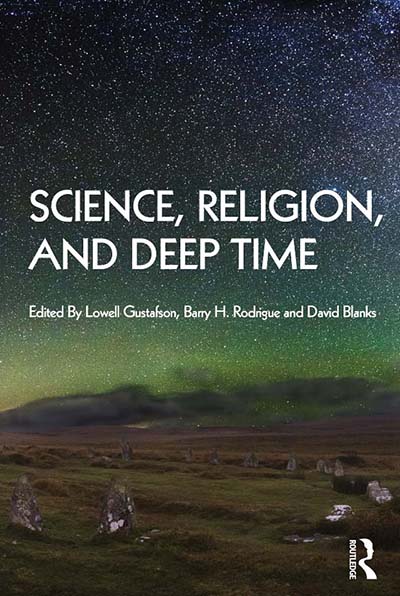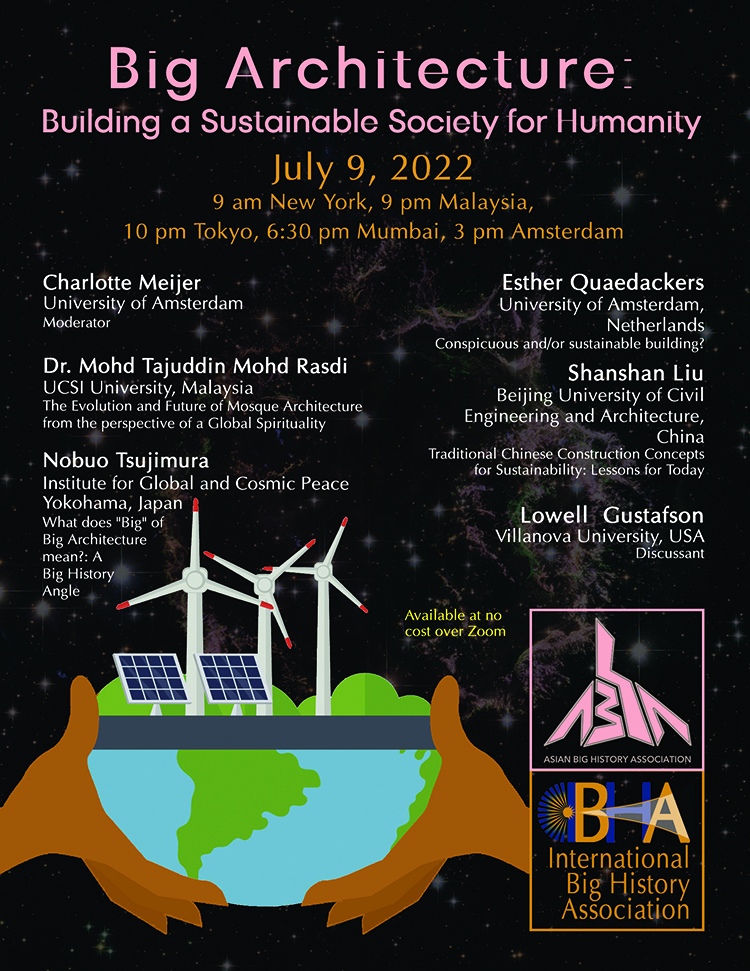
| The Big History of Consciousness - July 16 | Big History in Japan - August 7 |
| Evolution of Universe, Life, Humankind - August 17 | Big History in Philippines - August 20 |
| 2023 IBHA Conference Information | |
Panel on Big Architecture
 Charlotte Meijer
Charlotte MeijerUniversity of Amsterdam
Moderator
Charlotte Meijer is a graduate student at the University of Amsterdam’s faculty of humanities, specializing in the early modern period with a focus on the history of knowledge and human-animal relations. She has been involved in the organization of various big history courses at the UvA for the past six years. Through the Big History Project she also supports Dutch teachers who teach big history at the high school level.
 Dr. Mohd Tajuddin Mohd Rasdi
Dr. Mohd Tajuddin Mohd RasdiUCSI University, Malaysia
The Evolution and Future of Mosque Architecture from the perspective of a Global Spirituality
The architecture of the mosque is directly tied to the perspective and narrative of Islam in the modern world. The main intention of this talk is to present the mosque as a progressive and an inclusive architecture that can contribute both to nation building and global spiritual consciousness.
The present socio-political narrative of Islam in Malaysia and many parts of the Muslim worlds is governed by a narrow minded religious institution, an opportunist political leadership and an ignorant middle class of Muslims on both the subject matter of Islam as well as the need for a global inclusiveness in social, political, environmental and educational concerns. This talk will unravel the progressive aspect of Islam and the mosque from its early beginnings and trace its role and development through the historical, political and architectural frameworks through out the ages and in Malaysia in particular.
In Islam, the mosque was never a specifically defined building as prayers can be performed anywhere that is clean and its evolution in the post prophetic era was more a political and social development rather than religious. After that the mosque was more a military fort or garrison for the Muslim army and later on became a shelter for Muslim worship and politics in its empire era. In the 19th and 20th century of the modern state, Islam became a cultural element in social concerns and the mosque became a symbol of religion and religious activities.
During the 1970s, the Islamic Reformation Movement took many Muslim nations into an era of social and political change where the mosque was the center of community for Muslims. In the 21st century, the Islamic Reformation was hijacked by conservative and extremist elements as attested from the bombings and killings by the Islamic State Terrorists and the mosque reverted into a monumental symbol of state sponsored Islam without much liberty in thought, and social expressions. The discourse of mosque architecture is now frozen into a dogmatic and doctrinal Islam which has left the mosque into a stylistic construct of sustainability discussions as well as an historical adaptation of forms and artistic expression.
Finally, I will present the new directions of mosque as an element of inclusive nation building, as a centre for universal humanitarian aid and as an expression of architectural liberalism of technology, history and universal spirituality of form and functions. This talk is important to free Islam and the mosque into a global presence of spiritual growth and community building crossing the boundaries of faith, culture, technology and function.
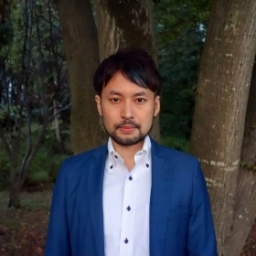 Nobuo Tsujimura
Nobuo TsujimuraInstitute for Global and Cosmic Peace
Yokohama, Japan
What does "Big" of Big Architecture mean?: A Big History Angle
The title of this webinar is Big Architecture. It shows our aim to rethink architecture in the light of big history. But what does "big" mean here? Big history sees everything beyond humans and Earth. So here the presenter focuses on nonhuman and space architectures and then tries to find hints for sustainability from them. We may be required to give a chance to fundamentally rethink and shed a new light on a fundamental question: why humans and other animals build something for living on earth.
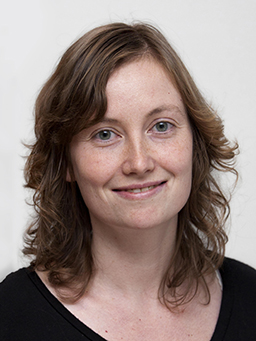 Esther Quaedackers
Esther Quaedackers University of Amsterdam, Netherlands
Conspicuous and/or sustainable building?
Humans are remarkable builders. Many of their buildings are special, but, perhaps surprisingly, not because humans use a lot of construction techniques that no other animal uses, or because they build much larger or more artistic structures than any other animal does. Human building is exceptional because in many situations, people combine building strategies that no other animal combines. They build in order to protect and organize their colonies, while using as little energy and materials as possible, like eusocial animals do. At the same time, they spend a lot of resources on aspects of building that help them to stand out from other members of their species, like artistic creatures such as bowerbirds do.
How did humans manage to combine these strategies, that are in a way at odds with each other, throughout their history?
This question is not just relevant for architectural history, but also for the future of building in a world characterized by dwindling resources. In such a world, it is useful to understand how our inclination to spend a lot of resources on certain aspects of building developed. It is even more useful to understand how that inclination developed in relation to ways to build while using as little energy and materials as possible. After all, such an understanding might help us develop less resource consuming and more sustainable building practices.
In order to address this question, the development of architectural traditions in both the eastern and western worlds will be explored. The differences and similarities between these traditions will contain lessons that are important for the future of sustainable building.
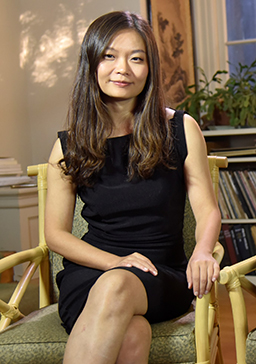 Shanshan Liu
Shanshan Liu
Beijing University of Civil Engineering and Architecture, China
Traditional Chinese Construction Concepts for Sustainability:
Lessons for Today
Ideological concepts play an important role in sustainable developments in a society. An influential ideology with ecological insights are likely to contribute to building a sustainable city and society. On the contrary, a social climate which lacks ecological concern may have devastating consequences for the society.
Chinese civilization has drawn lessons from a very long historical evolution. It can be observed that the civilization center shifted several times in Chinese primitive society; and each time the shifts followed an environmental collapse at the former site. This talk will discuss the ideological concepts on architecture, landscape and urban design in traditional Chinese society profoundly derived from the ecological and culture backgrounds of its origin.
Chinese ideology pursues the harmony between humankind and nature. The ideals of modesty and humbleness were essential elements in sustaining the society in China. The concepts' impact on architectural and urban design in China include restriction of large-scale constructions, depressing development of high-rise buildings and so on. These concepts acted as a safety valve to avoid extreme environmental and social collapse. And Chinese also strove to achieve a poetic dwelling integrated into the nature by garden design.
This talk will analyze the ecological background of the formation and development of Chinese concepts and examine how these values influenced architecture, landscape and urban design in different periods of Chinese history. It attempts to discuss the ecological insights behind these Chinese design concepts and their ideological and cultural significance for the development strategy of building healthy and sustainable cities and society today.
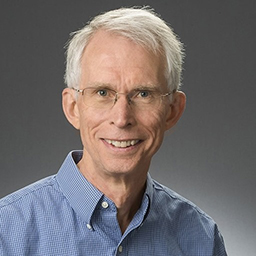 Lowell Gustafson
Lowell GustafsonVillanova University, USA
Discussant
Following Lowell's comments about the presentations, Charlotte will welcome questions and brief comments from everyone in attendance.
You are invited to a scheduled Zoom meeting.
Topic: Big Architecture: Building a Sustainable Society for Humanity
Time: Jul 9, 2022 09:00 Eastern Time (US and Canada; GMT-4)
Join Zoom Meeting
https://us06web.zoom.us/j/89984343354?pwd=VGVXR1FNNnI5ck5sVForbUpFWnMvZz09
| Members of the IBHA are committed to the widest possible availability of this presentation; it is open at no cost to all over Zoom. To support the programing of the IBHA and participate in our association, please consider joining and making a donation. |
